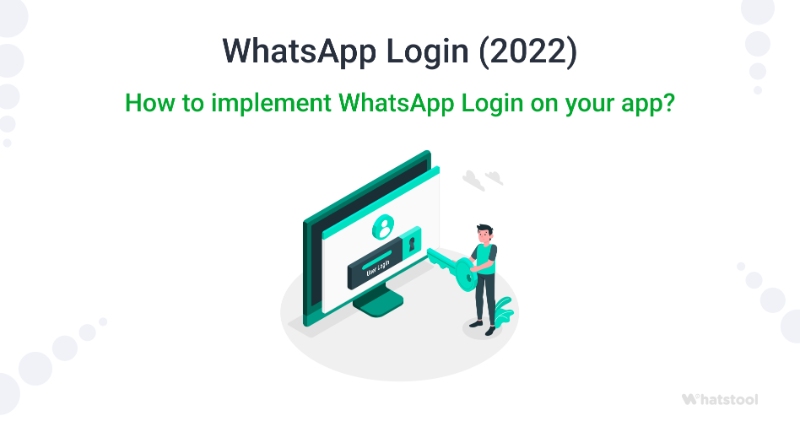
There are many third-party login systems now; the common ones are Facebook, Google and SMS. However, all of these may have flaws which could cause authentication errors and could cause problems.
Many times these login systems cause to trigger a third-party pop-up window which sometimes causes a connection session timeout, which is not ideal for security purposes.
OTP-based logins are very popular. However, they face some common problems of OTPs not having a 100% delivery rate that may lead to login drop-offs.
So what’s the best solution?
Implementing WhatsApp Login
WhatsApp is used by over 2 billion users worldwide, and it has already been a much-preferred substitute for text messaging. Moreover, WhatsApp is reliable as it depends on internet networks, not cellular ones.
The Whatsapp login authentication will make it easier for your mobile web users to log in without having to remember their passwords or enter their phone numbers or OTPs, giving them a seamless experience.
What’s the need for WhatsApp Login?
Millions of people endure the time-consuming login and authentication process each day. Users can currently log in by entering their mobile number, password, and OTP. As an alternative, they can sign in with their email or Facebook accounts.
A younger generation of users who don’t have Facebook profiles also frequently use phone numbers to sign up for services, and they occasionally use an email other than for this purpose.
What about mobile login through OTP verification?
It’s typical for the app to send a verification code through SMS to the specified number when a phone number is used to sign in. After entering that code, the user can establish an account.
In a multi-factor authentication system, when a user’s account information is paired with an additional step for added protection, this procedure can also be utilized when logging in.
Even though this procedure is simple to follow, SMS is not everyone’s preferred texting service, with WhatsApp being used by over 2 billion people.
Additionally, those without unlimited texting plans take care to minimize their usage of texting when possible.
To counter the limitations of SMS verification, the WhatsApp software development kit can come in as a handy solution. Apps can offer to send consumers their verification code using WhatsApp rather than text messaging after WhatsApp is incorporated into an iOS or Android app.
This makes it a lot easier for customers to sign up and log into your app or websites using just their WhatsApp phone number.
Login via WhatsApp Flow
So the flow of how we can implement this login system to any login requesting web application is frictionless and very easy to understand.

So from the above flow, you can easily tell that:
Step 1: The Web Application requests a unique login token from its database/server.
Step 2: The unique token from the server is sent to the web application.
Step 3: A WhatsApp Message is triggered to the registered user’s WhatsApp number.
Step 4: The WhatsApp Message is then pushed from the user to the WATI server.
Step 5: The WATI server sends the message to the web application’s server for validation.
Step 6: Triggers the result back to the WATI server.
Step 7: The Result is carried on as a WhatsApp message to the user to tell them if the login is valid/invalid.
Step 8: Login is then successful.
Finally, this is how the validation works when there is login via WhatsApp, making the login system more user-friendly.
Other benefits of implementing WhatsApp Login on your app?
- No encryption issue, like Google or Facebook.
- No waiting for OTP like in SMS.
- Do not have to type in anything and is hassle-free.
Using WhatsApp OTP for login
You may wonder why should you migrate from SMS OTP authentication to WhatsApp OTP. Well, it all boils down to popularity. If you serve customers in India and Brazil where WhatsApp is very popular, it’s a complete no-brainer to migrate to WhatsApp OTP authentication since it’s the preferred messaging platform.
Also since WhatsApp has over a 90% open rate, it would be ideal to switch all communication from SMS to WhatsApp to improve the user experience.
How safe is WhatsApp OTP login?
Instant messaging services like WhatsApp have end-to-end encryption that prevents anyone outside the sender and recipient from reading the messages. Although traditional institutions like banks may not feel confident using WhatsApp for sending OTPs since they are third-party providers unlike SMS messaging services provided directly by telecommunications operators.
About WhatsTool
WhatsTool is WhatsApp’s Official API Partner. The WHATSTOOL Platform currently allows you to create a WhatsApp Chatbot without coding. You can use the drag-and-drop chatbot builder or create a chatbot using keywords through WHATSTOOL. To know more about WHATSTOOL, visit the official website.
Read Other Blogs - view


